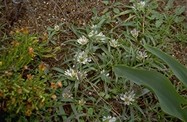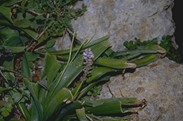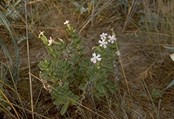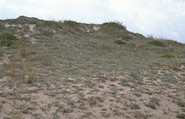Flora – Fauna
 Written by
Written by
Chrisoula Pantelidi
Stelios Alexandrakis
Petros Kastrinakis
5th grade students
The region's flora can be undoubtedly characterized as rich in native and sparse species. About 200 plant species have been indexed, 15 of which are native Cretan, while 7 of them are in the Greek Red Book of endangered plants. Eleven of these are protected by the Greek and European legislation. There are four significant ecotypes that are characterized as first priority ecotypes: the meadows with Neptune grass, the salty steppes, the reed beds and the seacoast's thickets with the junipers and the palm forest.  The Neptune grass meadows can be seen only in the Mediterranean and are indicative of very clean waters. They represent a very important refuge for the fish, which depend on them for food. Clusters of junipers (juniperus oxycedrus) and tamarisks (tamarix parviflora), characterize the area. Unfortunately, these trees are threatened by visitors mainly tourists) that have them cut in order to create parking places or to use them for putting on fires. A great number of sea daffodils (pancratium maritimum) impress the visitors with their awesome blossoms during summertime. Bushes such as the gray birdsfoot trefoil (lotus creticus), the Mediterranean thyme (coridothymus capitatus), the marram (ammopiyla arenaria) and the sea spurge (euphorbia paralias)dominate in the area. In the rocky coasts one can sea the Cretan dittany (origanum dictamnus), caper (capparis spinosa), thymes (coridothymus capitatus),
The Neptune grass meadows can be seen only in the Mediterranean and are indicative of very clean waters. They represent a very important refuge for the fish, which depend on them for food. Clusters of junipers (juniperus oxycedrus) and tamarisks (tamarix parviflora), characterize the area. Unfortunately, these trees are threatened by visitors mainly tourists) that have them cut in order to create parking places or to use them for putting on fires. A great number of sea daffodils (pancratium maritimum) impress the visitors with their awesome blossoms during summertime. Bushes such as the gray birdsfoot trefoil (lotus creticus), the Mediterranean thyme (coridothymus capitatus), the marram (ammopiyla arenaria) and the sea spurge (euphorbia paralias)dominate in the area. In the rocky coasts one can sea the Cretan dittany (origanum dictamnus), caper (capparis spinosa), thymes (coridothymus capitatus),  fringed rues (ruta chalepensis)and many other species. During winter you can admire a small blossomy lily called by the locals “ the Minoan lily (androcymbium rechingeri), which is a very important endangered species, met only in Crete and particularly in this area. Noteworthy are the catchfly (silene succulenta), which is a very sparse plant as well, the bellevalia(bellvalia brevipeticellata) the violet (viola scorpiuroides) and a sparse palm tree (phoenix theophrasti), all very rare endangered plants which have been integrated in the European direction 92/42 for special protection.
The region's fauna is mainly comprised of birds. 103 bird species have been indexed to date, 37 of them nest in the biotope or in the surrounding area. Twenty-one are protected by the Greek and
fringed rues (ruta chalepensis)and many other species. During winter you can admire a small blossomy lily called by the locals “ the Minoan lily (androcymbium rechingeri), which is a very important endangered species, met only in Crete and particularly in this area. Noteworthy are the catchfly (silene succulenta), which is a very sparse plant as well, the bellevalia(bellvalia brevipeticellata) the violet (viola scorpiuroides) and a sparse palm tree (phoenix theophrasti), all very rare endangered plants which have been integrated in the European direction 92/42 for special protection.
The region's fauna is mainly comprised of birds. 103 bird species have been indexed to date, 37 of them nest in the biotope or in the surrounding area. Twenty-one are protected by the Greek and  European legislation and are mentioned in the Red Data book of invertebrate animals. During spring's migration period many migrating birds are observed. These animals find refuge in this biotope after along journey that lasted very long. Among them you can sea the purple heron (ardea purpurea), the quail (coturnix coturnix), the ruff
European legislation and are mentioned in the Red Data book of invertebrate animals. During spring's migration period many migrating birds are observed. These animals find refuge in this biotope after along journey that lasted very long. Among them you can sea the purple heron (ardea purpurea), the quail (coturnix coturnix), the ruff  (philomachus pugnax), the hoopoe (upupa epops), the turtle dove (streptopelia turtur) and many others. Native species are the curlew sandpiper (calidris ferruginea) and the yellow-legged gull (larus cacchinans). During autumn's migrating period the species aren't so numerous but some are found in great amounts such as the stonechat (saxicola torquata) and the chiffchaff (phylloscopus collybita). Other permanent species are the shug (phalacrocorax aristotelis), the chukar (alectoris chukar) and the white magtail (motacilla alba). The diversity of invertebrate animals is mainly consisted of insects and mollusks. On the opposite shore there exist lizards, snakes the green toad (bufo viridis viridis) and the protected wood mouse (apodemus sylvaticus).
(philomachus pugnax), the hoopoe (upupa epops), the turtle dove (streptopelia turtur) and many others. Native species are the curlew sandpiper (calidris ferruginea) and the yellow-legged gull (larus cacchinans). During autumn's migrating period the species aren't so numerous but some are found in great amounts such as the stonechat (saxicola torquata) and the chiffchaff (phylloscopus collybita). Other permanent species are the shug (phalacrocorax aristotelis), the chukar (alectoris chukar) and the white magtail (motacilla alba). The diversity of invertebrate animals is mainly consisted of insects and mollusks. On the opposite shore there exist lizards, snakes the green toad (bufo viridis viridis) and the protected wood mouse (apodemus sylvaticus).
 Written by
Written by The Neptune grass meadows can be seen only in the Mediterranean and are indicative of very clean waters. They represent a very important refuge for the fish, which depend on them for food. Clusters of junipers (juniperus oxycedrus) and tamarisks (tamarix parviflora), characterize the area. Unfortunately, these trees are threatened by visitors mainly tourists) that have them cut in order to create parking places or to use them for putting on fires. A great number of sea daffodils (pancratium maritimum) impress the visitors with their awesome blossoms during summertime. Bushes such as the gray birdsfoot trefoil (lotus creticus), the Mediterranean thyme (coridothymus capitatus), the marram (ammopiyla arenaria) and the sea spurge (euphorbia paralias)dominate in the area. In the rocky coasts one can sea the Cretan dittany (origanum dictamnus), caper (capparis spinosa), thymes (coridothymus capitatus),
The Neptune grass meadows can be seen only in the Mediterranean and are indicative of very clean waters. They represent a very important refuge for the fish, which depend on them for food. Clusters of junipers (juniperus oxycedrus) and tamarisks (tamarix parviflora), characterize the area. Unfortunately, these trees are threatened by visitors mainly tourists) that have them cut in order to create parking places or to use them for putting on fires. A great number of sea daffodils (pancratium maritimum) impress the visitors with their awesome blossoms during summertime. Bushes such as the gray birdsfoot trefoil (lotus creticus), the Mediterranean thyme (coridothymus capitatus), the marram (ammopiyla arenaria) and the sea spurge (euphorbia paralias)dominate in the area. In the rocky coasts one can sea the Cretan dittany (origanum dictamnus), caper (capparis spinosa), thymes (coridothymus capitatus),  fringed rues (ruta chalepensis)and many other species. During winter you can admire a small blossomy lily called by the locals “ the Minoan lily (androcymbium rechingeri), which is a very important endangered species, met only in Crete and particularly in this area. Noteworthy are the catchfly (silene succulenta), which is a very sparse plant as well, the bellevalia(bellvalia brevipeticellata) the violet (viola scorpiuroides) and a sparse palm tree (phoenix theophrasti), all very rare endangered plants which have been integrated in the European direction 92/42 for special protection.
The region's fauna is mainly comprised of birds. 103 bird species have been indexed to date, 37 of them nest in the biotope or in the surrounding area. Twenty-one are protected by the Greek and
fringed rues (ruta chalepensis)and many other species. During winter you can admire a small blossomy lily called by the locals “ the Minoan lily (androcymbium rechingeri), which is a very important endangered species, met only in Crete and particularly in this area. Noteworthy are the catchfly (silene succulenta), which is a very sparse plant as well, the bellevalia(bellvalia brevipeticellata) the violet (viola scorpiuroides) and a sparse palm tree (phoenix theophrasti), all very rare endangered plants which have been integrated in the European direction 92/42 for special protection.
The region's fauna is mainly comprised of birds. 103 bird species have been indexed to date, 37 of them nest in the biotope or in the surrounding area. Twenty-one are protected by the Greek and  European legislation and are mentioned in the Red Data book of invertebrate animals. During spring's migration period many migrating birds are observed. These animals find refuge in this biotope after along journey that lasted very long. Among them you can sea the purple heron (ardea purpurea), the quail (coturnix coturnix), the ruff
European legislation and are mentioned in the Red Data book of invertebrate animals. During spring's migration period many migrating birds are observed. These animals find refuge in this biotope after along journey that lasted very long. Among them you can sea the purple heron (ardea purpurea), the quail (coturnix coturnix), the ruff  (philomachus pugnax), the hoopoe (upupa epops), the turtle dove (streptopelia turtur) and many others. Native species are the curlew sandpiper (calidris ferruginea) and the yellow-legged gull (larus cacchinans). During autumn's migrating period the species aren't so numerous but some are found in great amounts such as the stonechat (saxicola torquata) and the chiffchaff (phylloscopus collybita). Other permanent species are the shug (phalacrocorax aristotelis), the chukar (alectoris chukar) and the white magtail (motacilla alba). The diversity of invertebrate animals is mainly consisted of insects and mollusks. On the opposite shore there exist lizards, snakes the green toad (bufo viridis viridis) and the protected wood mouse (apodemus sylvaticus).
(philomachus pugnax), the hoopoe (upupa epops), the turtle dove (streptopelia turtur) and many others. Native species are the curlew sandpiper (calidris ferruginea) and the yellow-legged gull (larus cacchinans). During autumn's migrating period the species aren't so numerous but some are found in great amounts such as the stonechat (saxicola torquata) and the chiffchaff (phylloscopus collybita). Other permanent species are the shug (phalacrocorax aristotelis), the chukar (alectoris chukar) and the white magtail (motacilla alba). The diversity of invertebrate animals is mainly consisted of insects and mollusks. On the opposite shore there exist lizards, snakes the green toad (bufo viridis viridis) and the protected wood mouse (apodemus sylvaticus).